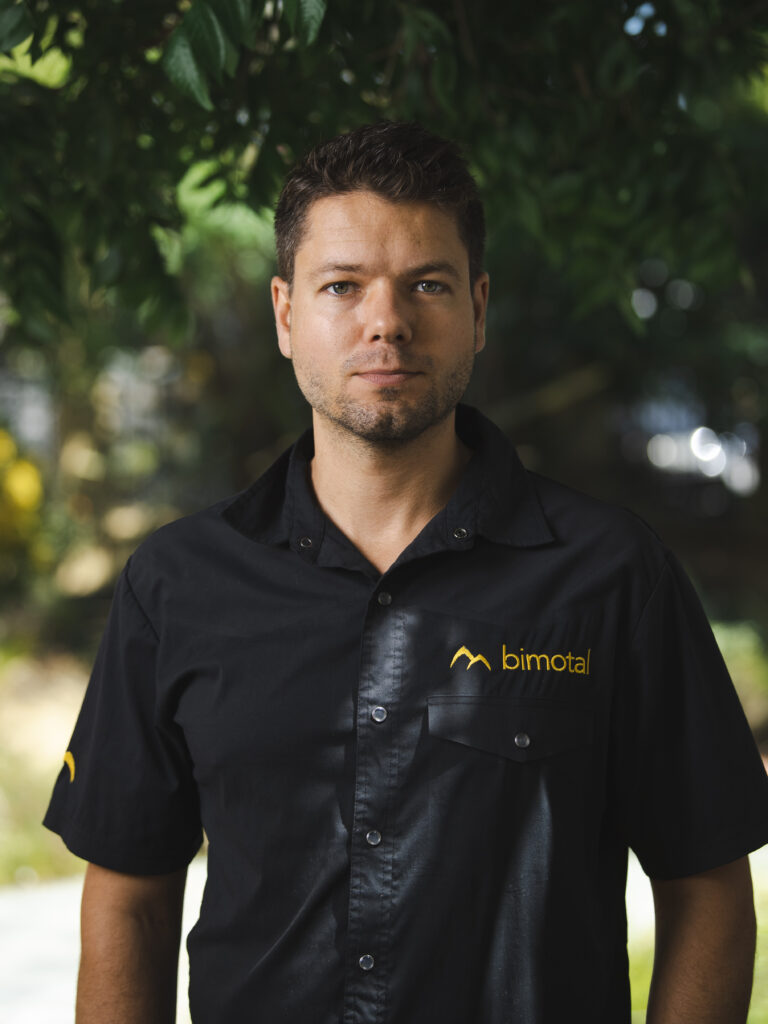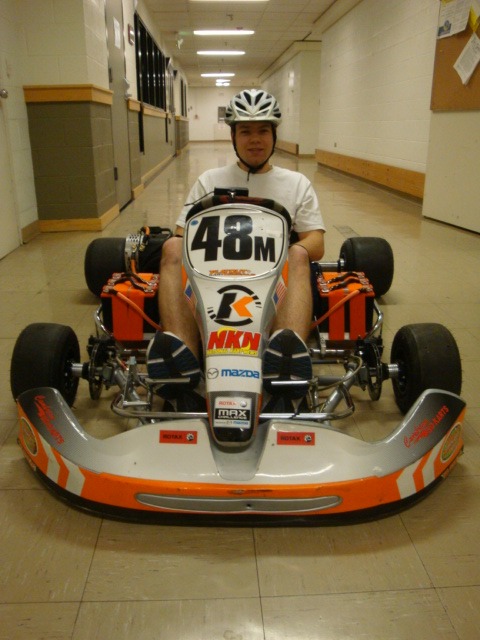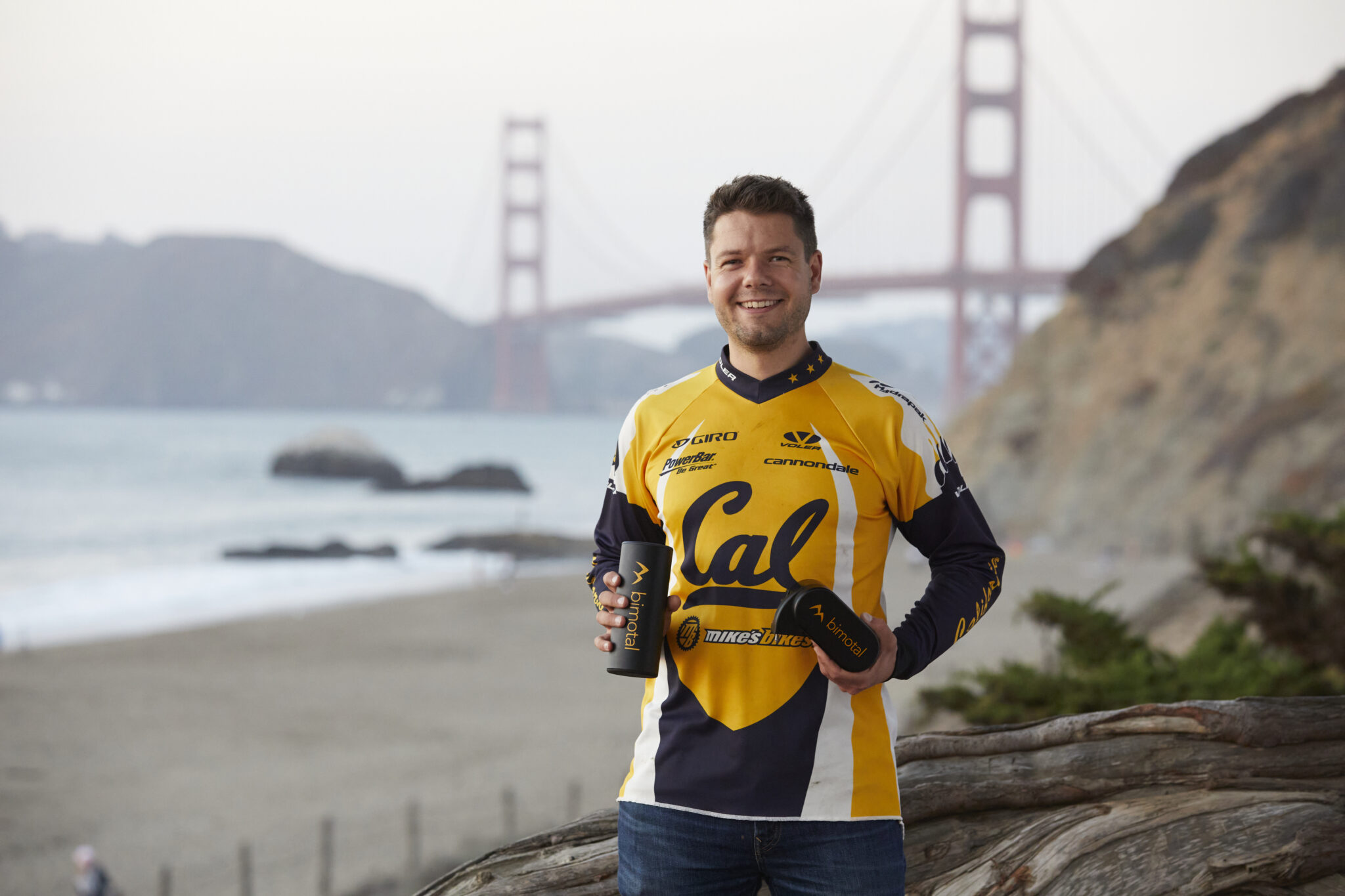After moving to the Bay Area at a young age, Toby Ricco ’13, M.S. ’14 knew he wanted to stay local when it came time to look at colleges. He ultimately chose UC Berkeley for its engineering program, graduating with a Bachelor of Science and a Master of Science in mechanical engineering. An entrepreneur since the age of ten, Ricco started a lawn-mowing business, interned at Tesla before college, and now builds electric batteries for small vehicles like mountain bikes and wheelchairs. Ricco leverages his passion for engineering and accessibility in his work at Bimotal, an electric powertrain technology company based in Berkeley.
The Cal Alumni Association spoke with Ricco for its Bears in Business series, where Cal alumni connect their time at Berkeley with their professional ventures.
CAA: Where are you from, and how did you choose Cal?
Toby Ricco (TR): Originally, I was born in Albuquerque, New Mexico, and I moved to the Bay Area when I was about seven.
Growing up, I always had a thing for tinkering and knew engineering was my path. When college apps rolled around, Berkeley was my top pick—it’s one of the best for engineering worldwide, plus my dad and granddad are alums. Ultimately, it was the school’s reputation, not my family legacy, that sealed the deal.
CAA: What were you like in college? Do you have any favorite memories from your time there?
TR: My time at Cal is dear to my heart. It was my first time away from home and living on my own. I still remember CalSo and Freshman Orientation, the first night away, being on campus in the dorms, and the impression it left on me. It all seemed so big.
Right from the get-go in my freshman year, I was just as driven as I’ve always been in life. I definitely wanted to do well at school and I dove head-first into research. I was trying to start an electric vehicle club and posted some flyers in Etcheverry Hall when a professor approached me with an alternative. He was like, “Why don’t you join my research group instead of starting the club?” And he tells me about this super cool project they were working on—something called the INSTAR program—which was research on flywheel-battery hybrid systems.
I started that right away in my first semester as a freshman. I pitched an idea: “Why not take this theory off the paper and build something real? Let’s make a go-kart, a functional proof of concept!” A go-kart is a lot more lab-friendly size-wise compared to a car. I had connections from my high school for building go-karts, so I got a go-kart to the lab, and the rest is history.
During my time at Cal, I played intramural soccer and was on the university’s cycling team. Off the field, I found a great circle of friends in my social fraternity, bonds that have stood the test of time and that I cherish deeply to this day. Looking back, I can genuinely say it was a rich blend of everything—academics, social connections, research, and a bit of sports.
CAA: How did your experiences at Cal shape your post-grad goals?
TR: Sometime before stepping onto the Cal campus, my passion for electric vehicles was already opening doors for me. Back in high school, I was that “crazy kid” turning go-karts into electric machines. Word got around, and soon enough, I was introduced to Jim Dunlay, the then VP of Powertrain at Tesla, thanks to a fellow student in my calculus class. This chance connection helped me secure an internship at Tesla at seventeen and fulfilled a dream that had taken root when I was only 12, tinkering with my first project of a revamped electric Razor scooter, right around the time Tesla was founded.
What Cal did was give me the tools to be extremely impactful. Both the research and coursework built my engineering acumen. I consider myself incredibly fortunate. The rigorous coursework at Cal was more than just theoretical; it equipped me with practical knowledge that translated into my daily responsibilities as an engineer. Whether analyzing mechanics or applying equations of beam bending, the concepts I mastered during my studies became vital tools in my role at Tesla and later as I founded Bimotal. Cal gave me the tools to be at the peak of my professional capability. More than teaching you basic facts: you learn how to learn at an institute like Cal.

CAA: Did you ever see yourself becoming an entrepreneur?
TR: I wanted to start a company since I was quite young. At ten years old, I started a lawn mowing business, and we had ten paying customers within a few months. My parents were amazing, super supportive, but they didn’t give me any handouts. If I wanted something, they said, “You’re capable. Go, earn some money.” I was ten years old, and what I wanted was a Sharper Image Electric Scooter. I just had to figure out how to get it. So I think it was a passion of mine from early on. I had five or six different jobs while I was in high school ranging from soccer ref to math tutor to go-kart repair mechanic/technician while still mowing lawns. I’ve always had the entrepreneurial bug.
CAA: What advice would you give current Cal students?
TR: Try as many things as you can. College is the best time to totally overcommit yourself and do too many things. Try that for a semester or two. Then find something you like and be a little more committed to it. Try different clubs and try different classes. Maybe you’re an engineer, but you want to try architecture. Or maybe you’re an English major, but you want to take a math class. Really use those electives and find opportunities to do things outside of whatever you think your trajectory may be. Explore. There’s no better time to do it.
Something I wish I had done was a semester abroad. Do that if you have the slightest inclination that you may want to study in another part of the world.
CAA: Anywhere in particular?
TR: Madrid, Spain. That would’ve been an awesome place to do a semester abroad.
CAA: How has your Cal education and experience influenced your business decisions today?
TR: In many ways. During my time at Cal, fulfilling the mandatory English requirements was a challenging yet rewarding journey for me, considering my affinity towards math. Initially, I underrated the power of proficient writing, but the classes at Cal reshaped my perception. Today, I appreciate that enriching experience. Writing is really important for building a business. It’s a key form of communication. You’re building pitch decks; you’re writing emails to investors. Something as simple as good writing quality can have an impact.
I also learned a lot during my experience in the INSTAR research lab where I raised money writing proposals and grants. I brought in about $80,000 while I was a student on the INSTAR team, co-authoring the largest proposal with Daniel Talancon, the Ph.D. leading the flywheel portion of the research. This experience was super valuable for raising capital in the real world.
The network I built at Cal is tremendously important to me. My first investor was a good friend from Cal who did financial engineering—Brodie Gay. He had seen my drive firsthand and had assured me, “I know how hard you work. You’re going to make this thing happen, I’ll invest in you.”
I was more exposed to diversity at Cal. It was a vibrant departure from my high school experience, amplified by the scale of the campus. I really appreciated that. I had international roommates and friends, many of whom English wasn’t their first language. They would have the same engineering class as me, and they’d approach a problem in a similar rigorous way, but they’d look at it slightly differently. Having this exposure at Cal really shaped how I wanted to build a company that would include people with varied backgrounds and unique perspectives.
“Cal gave me the tools to be at the peak of my professional capability. More than teaching you basic facts: you learn how to learn at an institute like Cal.”
Toby Ricco ’13, M.S.’14
CAA: Who influenced you the most as a mentor at or outside Cal?
TR: I have many mentors and advisors, but I’ll focus on the key ones during my time at Cal. Professor Dennis Lieu was the lead of the lab I worked in, and we interacted a lot throughout my time at Cal. He taught a motor design class, which I took and then became a teaching assistant for. I already loved electric motors, and now I had a deep understanding of how they worked.
Kameshwar Poolla taught an electrical engineering class. He taught in a style that was so clear. Everything just clicked. That was the coolest experience I had academically, and I am super grateful for it. EE100 was one of the few engineering classes I got an A+ in, and definitely the only one where it felt effortless and fun. Poola showed me how really complex topics, when thoroughly understood, can be simplified into crystal clear, smaller blocks of learning.
CAA: What is Bimotal? What do you do, and what is your goal for the company?
TR: Bimotal is an electric powertrain technology company. We make the electric motors, the batteries, and the software that make small vehicles go. If you think of an e-bike, we are the e-portion of an e-bike. That’s what we do.
Our goal is to reduce barriers to car-free mobility. We want to make e-bikes lighter, more reliable, and eventually cheaper as we get to scale. We also want to dive deeper into the reasons people don’t take bikes for short trips. For example, I use BART and experience the challenge of carrying an e-bike up and down stairs. The Bimotal Elevate creates a lighter e-bike solution that makes it feasible for more people to take an e-bike on trains, buses, and up/down stairs. Thirty pounds. That bike can be lifted by a much larger percentage of the population than a fifty pound e-bike.
CAA: How did you get interested in electricity, the bike industry, and starting your own company?
TR: I’ve always had a passion for mountain biking and efficient transportation. I was at Tesla for five years in Power Electronics prior to starting Bimotal. Bimotal was born from a need. A knee injury caused by a skiing accident resulted in my search for e-bike solutions. I looked into e-bikes. I looked into retrofit kits to put a motor on my bike because I loved the bike that I had. Both options were heavy and expensive. I kept looking at my bike, and thought, “There’s got to be a better way to get power to the wheel.” So that’s how the disc brake drive idea was born after two or three months of nightly staring at my bike for hours at a time.
That’s how Bimotal and its first product, Elevate, were started. From there, it evolved. I wanted to build technology, and that takes a bigger team and resources. We started talking to bike companies and landed a large contract to develop a mid-drive, which took our team and company to the next level and established us as a powertrain engineering company.
We were, and are, a bunch of former Tesla powertrain engineers thinking, “Hey, why aren’t the small powertrains better?” It’s a much tougher business than automotive. There isn’t the same level of revenue, and investment capital is tough to raise for bikes. That said, there are many studies showing that e-bikes are one of the only real ways to get the carbon emissions for the transportation sector to where they need to be. So even if it’s tough, it needs to be done. The team at Bimotal loves a challenge.
CAA: What does a typical day look like for you?
TR: Yesterday, I had nine meetings, six of which were interviews, two technical stand-ups, and one with a strategic partner. My days are sometimes chaos but usually planned chaos. I do my best to organize my time into functional blocks. For example: recruiting, fundraising, email catchup, and business development I will lump into one four-hour block. Another functional block will be engineering meetings, technical discussions, removing blocks for my employees—my top priority is almost always to make others more effective at their jobs—brainstorms, lab work, and supplier emails and communication. I strive to reduce task switching, which increases productivity and efficiency. But as a leader, I have to balance that with being a center communication hub that needs to keep things moving.
CAA: What are some of the challenges you’ve come across being a business owner? Did your time at Berkeley prepare you for any of these?
TR: I would say fundraising and recruiting are the two most difficult things and also the most impactful. These activities bring resources into the business. Capital can be converted into more people, equipment, engineering tools, or revenue (more capital), while additional employees bring brain firepower into the equation to solve design and manufacturing problems faster.
Nothing can fully prepare anyone to start a company. But Berkeley prepared me about as well as I could ask for. At one point in college, I was simultaneously leading a research lab, taking four engineering project classes as the project lead, on the mountain biking team, helping to run a social fraternity, balancing a girlfriend, and playing intramural soccer. That experience was the ultimate time management training.
CAA: What advice would you give to anyone who’s looking to start their own business?
TR: Pick something you’re insanely passionate about. There’s a quote on my childhood fridge which I’ll paraphrase: “Find something you’re truly passionate about, and do that. The world needs more passionate people.” I couldn’t agree more.
Do some research on the industry you’re going into. Know if you want to build a smaller business—people call these lifestyle businesses—or if you want to build a venture business. Knowing your goals and motivations is super important, and keep track of them as they evolve with time.
If you really want to do a venture business today, AI is probably your best bet. That’s something I wish I had more insight on before starting a company. Knowledge of what spaces are investable and how much the investment sentiment affects your odds of raising capital is important. It shouldn’t change the business you want to build. But it will change your strategy to fund your business. If you’re in a space that’s tough to raise in, you’ll probably have to stomach a slower ramp and need to focus on revenue or perhaps grant funding if it’s an energy tech/hardware startup.
Timing is important. I started Bimotal after five years of invaluable industry experience, when I hit production targets on Model 3, had a knee injury as my “need,” and an idea. There was a really good intersection of my hobby/passion, skillset, market need, and personal timeline. You may say I was lucky, and I have been incredibly fortunate in life. But the truth is I had a lot of people, my grandparents included, telling me I was insane to take the leap. “Luck” is being able to see an opportunity—and there’s always at least one—and having the gumption to take action on it.
CAA: Where can we find Bimotal products?
TR: You can pre-order on the Bimotal website. You can spot our first product, Elevate, on the trails as we have employees and some early customers riding units.
We’re ramping production through the end of this year. We aim to be at a build rate of 100 units per month by year’s end, and we’ll be shipping to more of our customers in a few months.
CAA: What was your favorite place on or around campus?
TR: The Fire Trail by Strawberry Canyon, above the pool. I would run that and go on hikes with friends. It’s my favorite for the views, the peace out in nature, and the fond memories I made on the trail with friends.
CAA: Do you have a favorite Cal memory?

TR: My favorite academic memory is working on the INSTAR go-kart and leveraging the research project towards a controls class (ME135) final project. I convinced my project team to work on the go-kart and tackle the problems of traction control and rear wheel torque vectoring. The fun part was testing. We set up a massive tarp in the Etcheverry breezeway and splashed a little bit of dish soap and water on the surface. The low friction surface was a hilarious testing ground for our traction control efforts. We had lots of students and professors stop by to see what we were up to. It was incredibly fun, and we did indeed manage to get the traction control to work reasonably well after a few days of effort, with us covered in soap spray by the end of each day.
My favorite social memory is from my fraternity. Weirdly enough, it wasn’t any specific event or party, though there are a few fond memories from those, but from my efforts as House-Improvements Chair. I hosted house improvement days and managed to get nearly all active members to pitch in. Anyone part of a social club will attest to how difficult this is. With thirty people working, we resurfaced our front deck rapidly, re-did a bathroom, painted various rooms, and improved many aspects of our house. The accomplishment and camaraderie are something I look back on and cherish—nothing gets you in the flow state like working towards a common goal with close friends. I get the same feeling as I work with an awesome team to build Bimotal into a company that has a major impact on the world.
CAA: What advice could or would you give current Berkeley students graduating in uncertain times?
TR: I’ll answer this with a story. There was a Berkeley student interviewing at Bimotal last summer for a mechanical engineering internship. This student ran through a technical interview with me and the responses were a bit shaky that I turned down this candidate.
I chatted with my team. They had good opinions and mentioned that the student was probably nervous. The candidate followed up with me later and said, “I really just want experience. I’d be willing to work for free.” That was super humbling, and I thought to myself, “Wow, anyone who’s that driven is someone I’d want at my company.” He got the internship and did a great job. Now he’s doing his Master’s. I have no doubt he’s going to find a job after he completes his Master’s.
Be willing to hustle. It is a tough time, but a lot of companies still need work. And think for yourself. Don’t do everything with ChatGPT; we can tell on applications. Just hustle, and you’ll find a way. I actually think we’re at the peak of the demand for engineers as hardware needs ramp back up with electrification and energy markets. Automation and robotics are gaining new momentum, and of course, software is still very hot with AI.
Learn more about Bimotal at bimotal.com, or contribute to their mission.
How does your Cal experience inspire you today? Share your story with us!
This interview was transcribed by Noa Berzon.





















